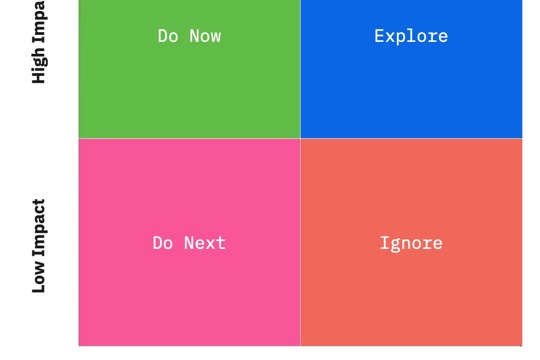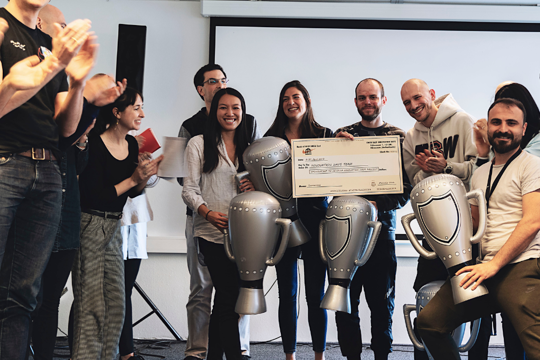
CHANGE LEADERSHIP
Asking for Golden Eggs
Why ask for golden eggs?
When it comes to leading teams through change, there's a fantastic mindset that came out of Japanese manufacturing–asking for golden eggs.
A golden egg symbolizes a problem without a readily apparent solution. Embracing golden eggs opens up a space for teams to share challenges without the pressure of having immediate answers. It is a direct turn away from the traditional mantra of "don't come to me with problems, come to me with solutions.”
Finding the right problem to solve
Focusing only on solutions can inhibit a team’s ability to get to the root cause of complex issues. Not to mention, attempting to solve everything can lead to fatigue, demotivation and even burnout on teams. When teams are in a constant state of firefighting, it’s hard to know where to focus first.
Instead, shifting the focus to finding the right problem to solve gives teams a sense of purpose and progress. This is where the golden eggs come in. When embracing the golden egg mindset, leaders empower their teams to share problems openly, creating an environment where challenges are viewed as opportunities for prioritising work and engaging in collective problem-solving.
Embracing the golden eggs
One of the things that you can do immediately is go back into your team and invite them to share some of the big challenges that they are facing in achieving a particular outcome, a strategic goal, a milestone, a successful project, whatever it might be.
Let people know it’s okay to not have the answer. What's critical is that you as the leader get sight of the big challenges that the team are facing–your golden eggs. Put those golden eggs on a post-it, then up on the wall and facilitate a discussion about them with the team.
Start by getting familiar with the challenges in front of you. Ask the team to tell you more about each challenge and how it manifests.
- Why is this an important challenge to tackle?
- Who does this challenge impact most?
- When is this challenge most problematic?
Once you understand the challenges, prioritise them using a simple effort/impact matrix. The effort impact matrix provides a structured framework to begin to assess and categorise challenges based on the interplay of effort required and potential impact on the organization. The matrix contains 4 unique quadrants:

- Low-effort, high-impact (upper left) challenges, represent the proverbial low-hanging fruit that promises substantial gains with minimal resource investment. These are the challenges you can start to tackle straight away to help give the team a sense of momentum.
- High-effort, high-impact (upper right) challenges, denote strategic initiatives that demand focused attention and allocation of significant resources. These are the challenges you’ll want to start building into a roadmap, setting milestones along the way to gauge incremental progress.
- Low-effort, low-impact (bottom left) challenges, can also be quick wins but may offer more marginal benefits than the quadrant above.
- High-effort, low-impact (bottom right) challenges are the cautionary zone. These are challenges that may not warrant the time, energy or monetary investment required.
By leveraging the effort impact matrix, you and your team can systematically prioritise challenges and channel your energy and resources more efficiently. This approach helps the team focus on finding the right problems to solve before ever starting to come up with solutions. It also separates the quick wins from the strategic endeavours so you can focus on solving the strategic challenges that most closely align with the overarching organizational goals.
For another approach to prioritising challenges and getting to ideas with your team in just 90 minutes, check out The Ultimate Team Meeting Kit.
Team problem-finding
If you find your team is hesitant to tell you about the biggest risks to your strategy, here’s what to do:
- Ask people to write down on a post-it the top 3 challenges they are facing in delivering the plan.
- Get them to select the one they feel most important to solve and ask them to re-write it as a question that starts “How might we…?” So instead of “We keep losing people from the team,” you might restate that as “How might we keep people in the team for longer?”
Reframing a negative problem as a more expansive, positive question, invites solutions later down the line. What’s more, the “might” means you are framing the problem in a way that might have many different solutions, meaning you get more options to choose from.
Create a culture of golden eggs
Leading change and innovation is not a solitary pursuit but a collaborative effort fueled by a shared commitment to addressing challenges. Leaders who adopt the golden egg mindset create a culture that values problem exploration, transforming obstacles into opportunities for collective growth and success.
Leaders must continuously foster this culture by celebrating challenges, reframing problems as opportunities, and recognizing that the collective wisdom of the team is the true driver of change.
So don't shy away from asking for golden eggs—encourage your team to share their challenges openly, and together, you'll hatch innovative solutions that drive success.
For more on change leadership, check out these articles:
CHANGE BY SPRINT VALLEY
Discover our award-winning Change methodology.
When leading Behaviour Change and innovation experts become your sidekicks, magic happens.
